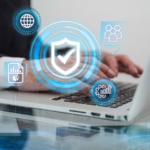
Top Four Security Risks in Cloud-Native Environments
March 17, 2025
The Critical Importance of IT Security Audits for Firms
March 17, 2025Introduction to Email Security Risks
Email security has emerged as a critical concern in today’s increasingly digital landscape. As individuals and businesses rely heavily on email for communication, the potential for threats that undermine email security has risen significantly. This reliance makes the understanding of email security risks essential for protecting sensitive information from malicious actors.
One of the most pervasive threats to email security is phishing. This form of cyberattack is characterized by the use of deceptive emails designed to trick recipients into divulging confidential information, such as login credentials or financial details. Phishing attacks often employ techniques that make the email appear genuine, further complicating the identification process for the average user. As a result, phishing remains a leading method for cybercriminals to gain unauthorized access to personal and organizational data.
Another significant risk is the proliferation of malware, which can be distributed through infected email attachments or links. Once malware infiltrates a system, it can lead to detrimental consequences, including data breaches, system outages, and financial loss. Moreover, spam emails contribute to the clutter of one’s inbox, making it difficult to identify essential communication and increasing the chances of overlooking legitimate messages.
Additionally, the rise of social engineering tactics has leveraged email vulnerabilities to manipulate individuals into making poor security choices. These threats can compromise both private and organizational information, leading to substantial reputational damage and financial implications.
Understanding these email security risks is vital for both individuals and organizations in developing effective strategies to safeguard their communications. Strengthening awareness of these threats can significantly reduce the risks associated with email usage, underscoring the importance of proactive measures in securing email environments.
Phishing: The Most Common Email Threat
Phishing is widely recognized as one of the most prevalent threats to email security. This technique involves cybercriminals impersonating legitimate entities to deceive individuals into providing sensitive information, such as usernames, passwords, and credit card details. These attacks typically manifest through emails that appear to be from trusted sources, such as banks, social media platforms, or even internal company communications. The hallmark of a phishing email often lies in its urgent tone, attempting to provoke immediate action from the recipient.
Attackers use various methods to lure victims into their traps. Common tactics include creating realistic-looking websites that mimic legitimate services, utilizing malicious links, and leveraging social engineering techniques to convince recipients of the email’s authenticity. For instance, an attacker may craft an email that warns the recipient of suspicious activity in their account, prompting them to click a link that leads to a counterfeit login page. Once the victim enters their credentials, the attackers gain access to sensitive information, which can lead to identity theft or financial loss.
Statistics unveil the alarming scale of phishing attacks. According to reports, 1 in 99 emails sent is a phishing attempt. The Anti-Phishing Working Group reported that in 2021 alone, there was a staggering increase in phishing attacks, with over 200,000 unique phishing sites being recorded. Notably, one high-profile case involved the compromise of a major email service, leading to significant data breaches affecting thousands of users.
With such severity, user awareness and education become paramount in mitigating the risks associated with phishing. Organizations should invest in training programs to inform employees about recognizing phishing attempts and implementing best practices for email security. By fostering a culture of vigilance and skepticism regarding unsolicited communications, organizations can better defend against this pervasive threat.
Malware and Ransomware in Email Communications
Email remains a prevalent vector for malware and ransomware attacks, posing significant risks to both personal and organizational data. Malware, short for malicious software, encompasses various destructive programs designed to harm or exploit systems, while ransomware specifically targets data by encrypting files and demanding a ransom for decryption. Understanding how these threats infiltrate email communications is crucial for mitigating their effects.
Email attachments are a common entry point for malware. Files disguised as legitimate documents, such as PDFs or Word files, can contain malicious code. Users often unwittingly download these harmful attachments, leading to system compromise. Additionally, links to compromised websites embedded in emails can trigger the download of malware upon a single click. Phishing emails, often masquerading as official communications, play a critical role in disseminating these threats, manipulating users into divulging sensitive information or executing harmful software.
Ransomware attacks are particularly insidious as they exploit vulnerabilities faster than traditional malware. Once infected, the ransomware encrypts files on the victim’s system, rendering critical data inaccessible. Attackers typically demand payment, often in cryptocurrency, to release the encrypted files, placing users in a distressing predicament. The consequences extend beyond individual discomfort; organizations can face significant operational disruptions, data loss, and damage to reputation, resulting in long-term financial implications and legal ramifications.
To shield against these threats, users should adopt preventive measures. Ensuring robust email filtering, utilizing advanced security solutions, and maintaining regular software updates can help identify and block potential malware before it enters the system. Implementing employee training focused on recognizing phishing attempts and cultivating a culture of security awareness further fortifies defenses against these pervasive email threats. By prioritizing vigilance and adopting best practices, both individuals and organizations can enhance their email security and reduce the likelihood of malware and ransomware incidents.
Best Practices for Enhancing Email Security
Email security is a critical aspect of safeguarding sensitive information and protecting against cyber threats. Organizations and individuals alike must adopt robust practices to mitigate potential risks effectively. One of the foundational steps in enhancing email security is the use of strong, unique passwords. Users should create complex passwords that combine uppercase and lowercase letters, numbers, and special characters. Importantly, passwords should be changed regularly to minimize the risk of unauthorized access.
In addition to strong passwords, enabling two-factor authentication (2FA) is highly recommended. This extra layer of security requires users to provide two forms of identification before accessing their email accounts, offering significant protection even if a password is compromised. By combining something the user knows (password) with something the user has (a mobile device or authentication app), 2FA greatly reduces the likelihood of unauthorized access.
Another crucial aspect of email security is the ability to recognize suspicious emails. Users should be trained to identify phishing attempts, which often take the form of emails that appear legitimate but contain malicious links or attachments. Vigilance against social engineering tactics is vital, and verifying the sender’s identity before responding or clicking links can prevent potential breaches.
Regularly updating software, including email applications and antivirus programs, is equally important. Outdated software can exploit vulnerabilities, making systems susceptible to attacks. Setting up automatic updates ensures that users receive the latest security patches without the need for manual intervention, which can sometimes be overlooked.
Finally, ongoing training and awareness programs for employees and individuals are essential. Educating users about the latest threats and best practices ensures that everyone remains vigilant and informed. By implementing these strategies, individuals and organizations can significantly enhance their email security and mitigate associated risks.




